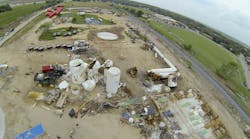OSHA and EPA should consider revising their regulations to address ammonium nitrate, and OSHA should step up its efforts to educate the fertilizer industry about existing standards that apply to ammonium nitrate, a government watchdog agency says in a new report.
The U.S. Government Accountability Office asserts that the deadly April 2013 fertilizer explosion in West, Texas, highlights the fact that “OSHA and EPA provide limited oversight of facilities that have ammonium nitrate.”
“OSHA’s regulations include provisions for the storage of ammonium nitrate, but the agency has done little outreach to increase awareness of these regulations within the fertilizer industry, a primary user. In addition, the regulations have not been significantly revised since 1971 and allow storage of ammonium nitrate in wooden buildings, which could increase the risk of fire and explosion,” GAO explains in the report. “Other OSHA and EPA chemical safety regulations –which require facilities to complete hazard assessments, use procedures to prevent and respond to accidents, and conduct routine compliance audits – do not apply to ammonium nitrate.”
The GAO report also calls on the federal government to improve data sharing among federal agencies and with states to give authorities a clearer picture of how many and which facilities have ammonium nitrate.
OSHA and EPA do not require facilities to report their ammonium nitrate holdings, while the Department of Homeland Security requires facilities with certain quantities to report their holdings for security reasons. Meanwhile, federal law requires certain facilities to report their ammonium nitrate holdings to state and local authorities, “but these data are not routinely shared with federal agencies.”
“Federal data provide insight into the number of facilities in the United States with ammonium nitrate but do not provide a complete picture because of reporting exemptions and other data limitations,” the report says.
An August 2013 executive order from President Obama called for the formation of a working group to improve coordination and information sharing among federal agencies and with states. However, the GAO report notes that “this work is not yet complete.”
Fertilizer Industry Claims Ignorance
The report asserts that OSHA needs to ramp up its efforts to educate the fertilizer industry about applicable safety standards – namely 1910.109, Explosives and Blasting Agents – and target high-risk facilities for inspection.
“Fertilizer industry representatives we interviewed said that prior to the explosion in West, Texas, they did not know that OSHA’s ammonium nitrate storage regulations applied to the fertilizer industry, and they suggested that OSHA reach out to the fertilizer industry to help prevent another incident,” the GAO report says. “Industry representatives explained that their understanding was based on a proposed rule published by OSHA in the Federal Register on April 13, 2007, which proposed revisions to the Explosives and Blasting Agents regulation.”
Based on their interpretation of the 2007 proposed rule, fertilizer companies believed that OSHA’s nitrate-storage requirements only applied to ammonium nitrate used in the manufacture of explosives – not to ammonium nitrate fertilizer, the GAO report says.
The report points out that OSHA recently published information about how the agency’s Explosives and Blasting Agents regulations apply to ammonium nitrate fertilizer. The agency updated its website to refer to its storage regulations for ammonium nitrate fertilizer, and an August 2013 chemical advisory – issued jointly by OSHA, EPA and the Bureau of Alcohol, Tobacco and Firearms – states that OSHA’s Explosives and Blasting Agents regulations contain requirements for the storage of all grades of ammonium nitrate, including fertilizer-grade ammonium nitrate.
In February, OSHA announced that the agency is working with the fertilizer industry to remind employers of the importance of safely storing and handling ammonium nitrate. OSHA published a letter on its website providing employers with legal requirements and best-practice recommendations for safely storing and handling ammonium nitrate.
